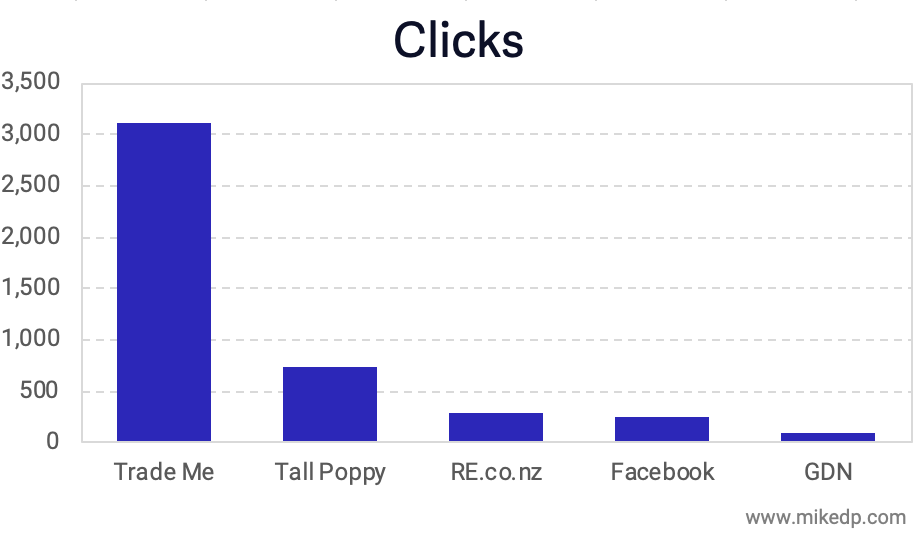Reposted with permission from Mike DelPrete.
I’m selling my house in New Zealand. As part of the process, I’m advertising the property on the major property portals as well as Facebook and Google.
It’s a perfect opportunity to evaluate the pricing and performance of the various advertising channels, and reveal — in a real world scenario — how irrational the system can be.
BackgroundIn New Zealand, there is no MLS system that has all properties for sale. That job falls to the real estate portals, and the business model of those portals is pay-to-list.
New Zealand (in addition to Australia) is also a vendor-funded marketplace, meaning the homeowner pays the advertising costs, not the real estate agent. And for this transaction, I’m using a Tall Poppy real estate agent, the company where I’m an independent director.
Cost per channelWhen listing my house, I was presented with several advertising options. Trade Me (where I used to work) is the leading real estate portal, and realestate.co.nz is the No. 2 portal. Facebook and the Google Display Network (GDN) are alternative advertising options.
 The 6 features your luxury seller should upgrade
Getting a luxury home into selling shape is all in the details READ MORE
The 6 features your luxury seller should upgrade
Getting a luxury home into selling shape is all in the details READ MORE
In the world of real estate portal strategy, I was curious to evaluate their effectiveness. Are they truly competition to the portals?
 There is a significant cost difference between the No. 1 and No. 2 portal; Trade Me is over five times more expensive, but is it five times as effective?
There is a significant cost difference between the No. 1 and No. 2 portal; Trade Me is over five times more expensive, but is it five times as effective?
The easiest measure of advertising effectiveness are clicks to the property listing. In this case, as is the case with many real estate portals around the world, the top portal is absolutely dominant. At the time of analysis, Trade Me generated over 10 times the clicks to my property listing than the runner-up portal — 3,100 versus 300.

(It’s worth noting that the Tall Poppy website generated more clicks for my listing than the No. 2 portal, reinforcing the continued importance of a real estate agent’s web presence to advertising listings.)
Cost per clickTo measure the overall cost effectiveness of the advertising options, we reviewed the cost per click.
 Trade Me, the top portal, is not only the most effective, but also the most cost effective — by a wide margin. Although Trade Me is over 10 times more effective than the runner-up portal, it is only 5.5 times more expensive.
Trade Me, the top portal, is not only the most effective, but also the most cost effective — by a wide margin. Although Trade Me is over 10 times more effective than the runner-up portal, it is only 5.5 times more expensive.
Assigning a value per click of $0.30 (the blended average), Trade Me delivered $936 of value for $549, while the runner-up portal only delivered $89 of value for $99 — a negative return on investment.
It turns out that Facebook is a legitimate advertising channel, but it doesn’t come close to replacing the portals as the primary advertising channel — in terms of clicks and cost effectiveness. GDN is simply not cost effective.
FindingsReal estate, and real estate advertising, is a non-rational system. Decisions are made based on emotions, not facts. And this transfers to the world of real estate portals and pricing strategies.
A portal’s pricing doesn’t always align with its effectiveness. There are more systems at play that influence — and restrict — a portal’s pricing strategy, namely the risk of alienating customers by aggressively raising fees and pressure from competitors.
For the time being, the top portal in each market — Zillow, Rightmove, REA Group, ImmoScout, Trade Me — commands a dominant position. Being the place where “everyone goes to search for property,” even with alternate options, most often yields exponentially more effective results than the competition.
Mike DelPrete is a strategic adviser and global expert in real estate tech, including Zavvie, an iBuyer offer aggregator. Connect with him on LinkedIn.
Source: click here
















